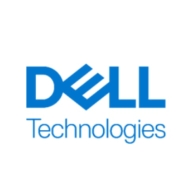


Dell PowerMax and HPE Primera are leading competitors in the enterprise storage category, with PowerMax often seen as having the upper hand due to its superior performance and reliability.
Features: Dell PowerMax stands out with its advanced data reduction techniques including deduplication and compression, integrated NVMe-based back-ends, and robust analytics through CloudIQ. It offers near-zero downtime due to its storage consolidation capabilities. HPE Primera is notable for its predictive analytics via InfoSight, efficient Kubernetes integration, and support for NVM drives.
Room for Improvement: PowerMax users have noted the need for improved deduplication ratios, better NVMe over-fabric support, and a more user-friendly GUI. HPE Primera could enhance its market appeal with more competitive pricing options and improved integration with external Key Management Systems. Users have also pointed out the occasional hardware glitches and a need for better technical support response.
Ease of Deployment and Customer Service: PowerMax is praised for its positive deployment experience and robust customer support from Dell EMC, often excelling in managing complex enterprise environments. Primera is commended for its straightforward setup and integration, though there's feedback asking for improved SLA handling.
Pricing and ROI: While Dell PowerMax may be in a higher pricing bracket, the investment is often justified by its comprehensive feature set and enterprise-level reliability, translating to significant ROI through operational efficiencies. HPE Primera is competitively priced with a good price-to-capacity ratio but may involve additional costs for certain services, unlike PowerMax which often includes these in its package.
If you wait more than seven years to buy another one, you get a return on your investment.
During a DCDR setup and migration from VMAX to Dell PowerMax, what was planned as a two-day downtime was completed in just three to four hours.
The performance metrics or benchmarks I use to measure success with Dell PowerMax include uptime as well as our response times on our platforms, both of which are exactly where we want them to be, which is five nines and as fast as possible.
My client has seen significant ROI since the install, and when you don't go down, that's an ROI in and of itself.
Customers always have their issues resolved promptly.
Technical support is good at least through vendors, not directly with the principal.
I would rate Dell PowerMax support as a ten, as I have never had an issue with Dell support as it relates to this product.
ProSupport Next Business Day offers part replacement within four hours for data leaks.
Dell support for Dell PowerMax is exceptional, rating a perfect 10 out of 10.
We could not get a genuine explanation for why systems were failing under certain conditions.
It is highly scalable.
It hasn't broken down anytime in the last six to seven years, despite hurricanes, earthquakes, and power outages.
Scalability is not an issue.
Dell PowerMax is good for enterprises, and it also depends on how much workload you're going to bring in on Dell PowerMax in terms of performance and how many users are going to use the database you're hosting.
PowerScale is better suited for AI and overall buzz solution currently.
I would rate the stability of the product at seven out of ten.
These patches can be applied on the fly without requiring software upgrades or system downtime.
I would rate it nine out of ten since there are no required downtimes, even during firmware upgrades.
There has been no downtime with Dell PowerMax; it's been extremely reliable, easy to manage, easy to upgrade, and trustworthy as we've upgraded over the years from one version to another.
The system operates smoothly even with a greater IOPS capacity enabled by using SSD disks.
We would appreciate a built-in transparent failover in the next release to eliminate the need for a separate metro cluster.
One way to improve the product is to add an operational assistant that doesn't depend on VMware.
I would like to see some AI features that would allow arrays to intelligently identify threats or unusual behavior in the data pattern and give an alert.
Compared to competitors such as NetApp, which integrates with public cloud hyperscalers (GCP, Azure, AWS), Dell PowerMax lacks in this aspect.
Dell can assist by providing plug-and-play integrated templates that allow customers to drag, drop, modify, and connect with any target system for generating snapshots without logging into the storage directly.
Dell PowerMax NVMe is very reliable storage and cannot experience downtime.
The user interface is friendly, yet it does not cover all steps that can be performed via direct port connections on storage.
While the prices may be higher than those of other vendors, we see it as a market leader with benefits.
The support can be a bit pricey, but the solution is more cost-effective than anything else out there.
I would rate the solution as an eight out of ten in terms of costliness.
The higher cost compared to other vendors is justified by additional features, vendor-managed upgrades, and superior support services.
It is the best choice for large projects in terms of price and features compared to midrange solutions.
The price is starting from $500,000.
Its data compression feature is the best that we have ever seen.
The standout features for us in Pure FlashArray X NVMe are its robust DDoS protection, seamless transparent failover, and failback capabilities ensuring high availability.
Pure FlashArray X NVMe helps to improve our processing speed.
NVMe provides additional fast cache, similar to random access memory (RAM), which improves overall system performance and read/write experience for users.
Dell PowerMax NVMe is very supportive of our operational growth since we require daily performance from our core banking systems and need to facilitate data movement efficiently.
The key benefits of using Dell PowerMax, quantified in terms of saved hours and saved costs, is having one single platform that provides functionality to all of our internal customers.
We have more capacity than expected, and even if we face issues with one or two disks, the system maintains the same performance.
| Product | Market Share (%) |
|---|---|
| Dell PowerMax | 4.8% |
| HPE Primera | 3.1% |
| Pure FlashArray X NVMe | 1.4% |
| Other | 90.7% |


| Company Size | Count |
|---|---|
| Small Business | 15 |
| Midsize Enterprise | 11 |
| Large Enterprise | 12 |
| Company Size | Count |
|---|---|
| Small Business | 17 |
| Midsize Enterprise | 15 |
| Large Enterprise | 55 |
| Company Size | Count |
|---|---|
| Small Business | 19 |
| Midsize Enterprise | 8 |
| Large Enterprise | 14 |
Pure Storage FlashArray//X is the world’s first enterprise-class, all-NVMe flash storage array. It represents a new class of storage – shared accelerated storage, which is a term coined by Gartner – that delivers major breakthroughs in performance, simplicity, and consolidation.
PowerMax leads in mission-critical enterprise storage with advanced architecture and AI-driven automation, ensuring secure and efficient IT optimization. Its multi-node NVMe scale-out framework delivers unmatched performance and consolidation, backed by Dell’s Future-Proof Program.
PowerMax is renowned for its robust reliability, performance, and efficient data reduction capabilities. Users benefit from its NVMe architecture, aiding significant scalability and cost efficiency through effective deduplication and compression. Unisphere simplifies management, while CloudIQ provides enhanced monitoring. With high availability and strong IOPS capabilities, PowerMax effectively manages demanding workloads and ensures seamless operations. Its compact design and increased storage capacity enhance user experience, particularly with easy maintenance and robust performance.
What are the key features of PowerMax?Dell PowerMax is predominantly employed in mission-critical applications such as SQL, Oracle databases, ERP systems, and high transactional environments. Healthcare, finance, and e-commerce sectors leverage its high performance, scalability, and NVMe technology for low latency and redundancy. It is adept in storage consolidation, data analytics, and disaster recovery.
HPE introduces HPE Primera, a new storage platform designed to deliver superior simplicity, availability, and performance for mission-critical applications
HPE Primera advances the HPE Intelligent Data Platform, a portfolio of products and solutions designed to help customers transition from delivering storage to unlocking business value with intelligent data
We monitor all All-Flash Storage reviews to prevent fraudulent reviews and keep review quality high. We do not post reviews by company employees or direct competitors. We validate each review for authenticity via cross-reference with LinkedIn, and personal follow-up with the reviewer when necessary.